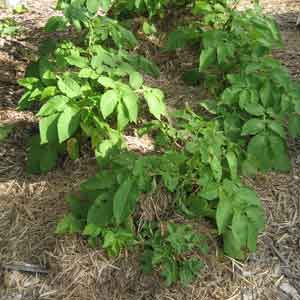Some people say that the place to be in gardening is no longer just in sustainability – it’s being regenerative. But isn’t that where SGA been all these years? We’ve been helping you learn how to improve your soil, your garden’s productivity, nurture the planet and produce food which will keep/make you healthy. We’re not changing the name of our organization to keep up this trendy buzzword, but let’s look at what regenerative garden enthusiasts mean by the term and how it relates to what SGA encourages gardeners to do.
What is it?
The concept of “Regenerative gardening” has evolved from a combination of sustainable/regenerative agriculture, agroecology, agroforestry, sustainable gardening with some permaculture thrown in. It is, however, unclear from where it first emerged i.e growing plants, feeding people, using the natural features of the land, water and nature in general to enhance productivity, minimizing harm to the environment and even making a positive contribution to it. Indeed, all these movements have drawn on observations of many of the ancient, traditional farming systems of indigenous peoples around the world.
Regenerative agriculture
According to the WA Landcare Network, farmers engaged in regenerative farming “have practised a holistic approach to land management that keeps water in the landscape, improves soil health, stores carbon and increases biodiversity.” It aims, thereby, to improve the quality of food grown on the land. An important means of improving the soil is to increase its carbon content which is sometimes referred to as “carbon farming”. Through soil improvement, soil biota will increase along with water-holding capacity. Such soil will produce more and better quality food leading to the concept of “food forests”.
A small, but increasing, number of farmers are practicing regenerative agriculture as they observe declining productivity and landscape degradation as a result of conventional farming methods.
Regenerative Gardening, Urban Agriculture and Food Forests
There have been many incentives for urban dwellers to establish local food production rather than rely on that which is commercially produced. Urban food production is occurring on land of various sizes ranging from balconies and roofs through standard house blocks, to many hectares of either public or private land. Among these incentives are:
- Higher quality, fresher fruit, nuts and vegetables
- Concern about environmental impacts on soil and water in conventional systems
- A desire to reduce food miles
- Increasing interest in plant-based diets rather than those based on animal protein – driven by attempts to reduce carbon dioxide emissions and inefficient use of soil and water resources as well as minimising harm to animals
- Concerns about chemicals used in agriculture and which are increasingly being detected in humans.
Characteristics of Regenerative Gardening and Farming
In the paragraphs below we have added links to pages on this SGA website which address these characteristics.
Learning from natural systems
Forests, grassland and other ecological communities maintain themselves by changes in their physical components or human intervention if not interfered with. In such ecosystems the physical components (landform, soil, water, air) work together to determine the living organisms (plants, animals, microbiota) and determine energy flows and nutrient cycles (https://www.sgaonline.org.au/garden-like-a-natural-farmer/ ). Although regenerative gardening or farming involve growing plants that are not indigenous to the area, attention to all other components is given, thus a more holistic approach is taken rather than just a focus on getting repeated production of a particular crop.
Minimal soil disturbance
This means not tilling or digging the soil so that its structure is maintained – i.e. spaces for air and water flows and for root penetration. This can be achieved by no-dig garden beds or no-till practices. In no-dig garden beds the growing medium is created by adding layers of soil, organic plant material and animal manures (https://www.sgaonline.org.au/how-to-make-a-no-dig-garden/). No-till means that after crops are harvested, the ground is not ploughed or dug, roots are left in the ground and weeds may be destroyed by solarization (see below). Another technique, soil aeration, using aerators – tools with prongs which punch holes – is still less damaging than ploughing or digging.
Sheet mulching
 Mulches of either organic or non-organic materials are used between the planted crops to inhibit weed growth and retain moisture. They are also used to kill weeds and build soil on ground that has not yet been planted for crops (https://www.sgaonline.org.au/choosing-mulch-for-your-garden/ ). The materials are usually cardboard, newspaper, woodchips, straw or a combination. These all have the advantage of adding carbon to the soil and encouraging microbial growth. In small areas where perennials, not annuals, are grown, inorganic material can be used e.g. stones, but these do not add any nutrition.
Mulches of either organic or non-organic materials are used between the planted crops to inhibit weed growth and retain moisture. They are also used to kill weeds and build soil on ground that has not yet been planted for crops (https://www.sgaonline.org.au/choosing-mulch-for-your-garden/ ). The materials are usually cardboard, newspaper, woodchips, straw or a combination. These all have the advantage of adding carbon to the soil and encouraging microbial growth. In small areas where perennials, not annuals, are grown, inorganic material can be used e.g. stones, but these do not add any nutrition.
Crop rotation
Plants to be harvested or those in the same plant family, are not grown in the same area in the subsequent season. This minimizes the risk of host-specific pests and disease and also of excessive depletion of particular essential nutrients (https://www.sgaonline.org.au/crop-rotation/ ). There are many systems of rotation, some consisting of 4 cycles, one of which is a legume to add nitrogen to the soil. In other systems, and it may be many years before the initial crop is planted in the same place again.
Cover crops
Associated with crop rotation is the use of cover crops or green manures (https://www.sgaonline.org.au/green-manure/) . As in nature, soil is never left bare thus reducing weed invasion and erosion. Such crops are usually either grasses or legumes. Both add organic matter to the soil because root systems are left in place. They also prevent water runoff thus reducing erosion, increase biodiversity by attracting different insects and microbes from the previous crop and break cycles of host-specific disease. Crops with deeply penetrating roots can help break up compacted soil.
Legumes, so-called green manures, have the extra advantage of enriching the soil because of their nitrogen-fixing capabilities.
Cover crops are cut down or mown just before maturity and either left as surface mulch or lightly dug in.
Solarisation of weeds
Rather than pulling or poisoning weed-infested of grassy areas prior to planting crops, regenerative/sustainable gardeners cover the soil with either black or clear plastic with the edges held firmly in place (https://www.sgaonline.org.au/life-without-lawn/ ). Under clear plastic, weeds grow and cook in the heat. Black plastic minimizes growth by cutting off sunlight, but the plants still cook. As long as seed production has not occurred, remaining organic matter can be left in place to add to soil quality or it can be removed and composted.
Compost
Artificial fertilisers are not used and importation of manure is minimized. Rather, all organic waste from pruning, mowing or remains of plants after fruit/seed harvest are composted. Manure from on-site animals is an excellent addition to compost heaps. Mature compost not only minimizes waste but improves soil quality, fertility and structure (https://www.sgaonline.org.au/the-science-of-composting/ , https://www.sgaonline.org.au/creating-compost/) .
Perennials
Shifting focus from annual to perennial crops means that living roots are in the soil all the time, reducing compaction and erosion and providing host material and nutrition for soil microbiota. In addition to providing fruit or nuts, trees also are stable stores of carbon. Other such stores are vegetables which are perennial in the right climate.g. rhubarb, artichokes, asparagus, seakale, sorrel, breadfruit, sweet potato and many more. A new perennial relative of wheat, kernza, has been dev eloped and may be a promising alternative to annual wheat.
eloped and may be a promising alternative to annual wheat.
Natural Pest and Disease Control Rather than Chemicals
It is increasingly recognized that chemical use in plant systems often causes harm to beneficial organisms and tends to encourage development of resistance so that ever harsher chemicals are required. Regenerative agriculture and regenerative gardening rely on the natural ecosystem to keep pests and diseases under control. Natural systems are not monocultures, but complex arrays of plants and animals living in balance with one another. While such systems are not easy to create and harvest from in gardens or farms, it is possible to encourage biodiversity by using plants which mutually benefit each other through complementary nutrient requirements or production of helpful chemicals or to attract a range of beneficial insects and organisms which keep pests and disease under control. Such systems use companion planting (https://www.sgaonline.org.au/companion-planting/ ).
By utilizing all the above approaches soil is improved, the ecosystem is enhanced, carbon is trapped and productivity increases. What could be better?
Further Reading
https://www.onegreenplanet.org/lifestyle/build-regenerative-garden/
Related Articles:
Citizen Science: A Pathway to Gardening Success and Biodiversity Conservation
In recent years, the realm of science has experienced a remarkable transformation, one that invites people from all walks of life to participate…
A Sustainable Gardener’s Guide to Thrifty Gardening
Creating an eco-friendly and cost-effective garden involves more than just nurturing plants; it's about adopting a sustainable approach that…



